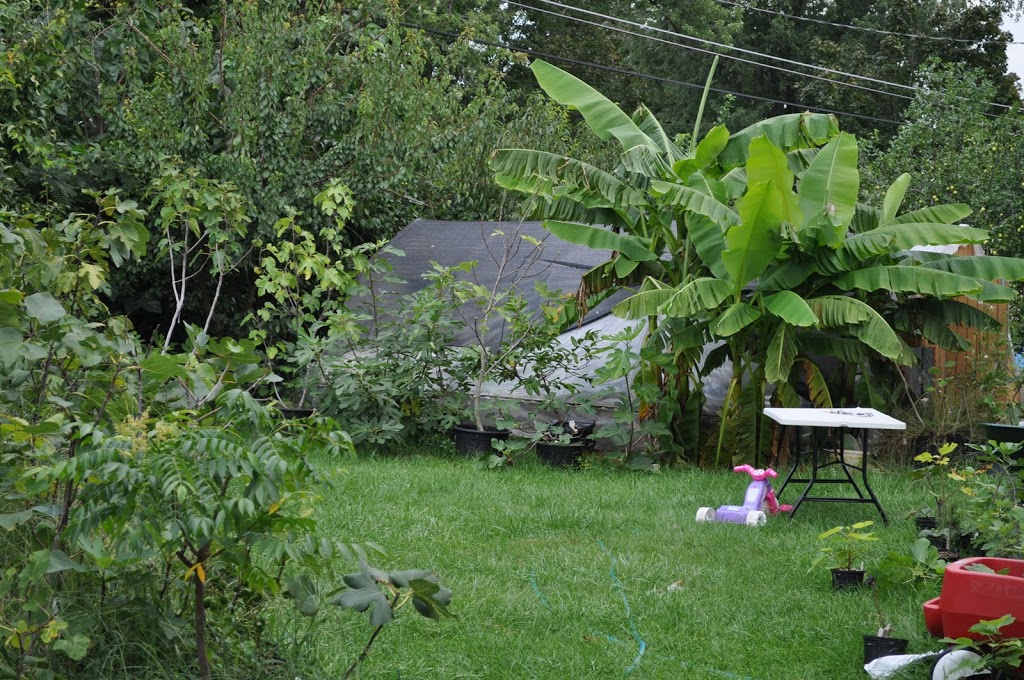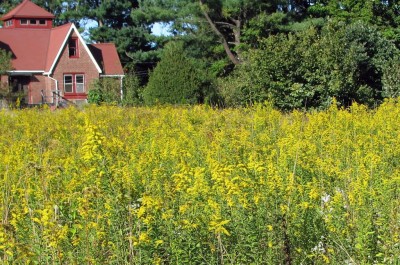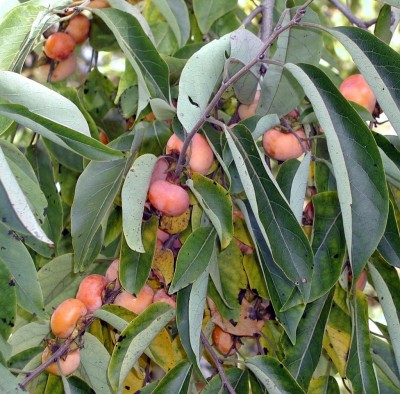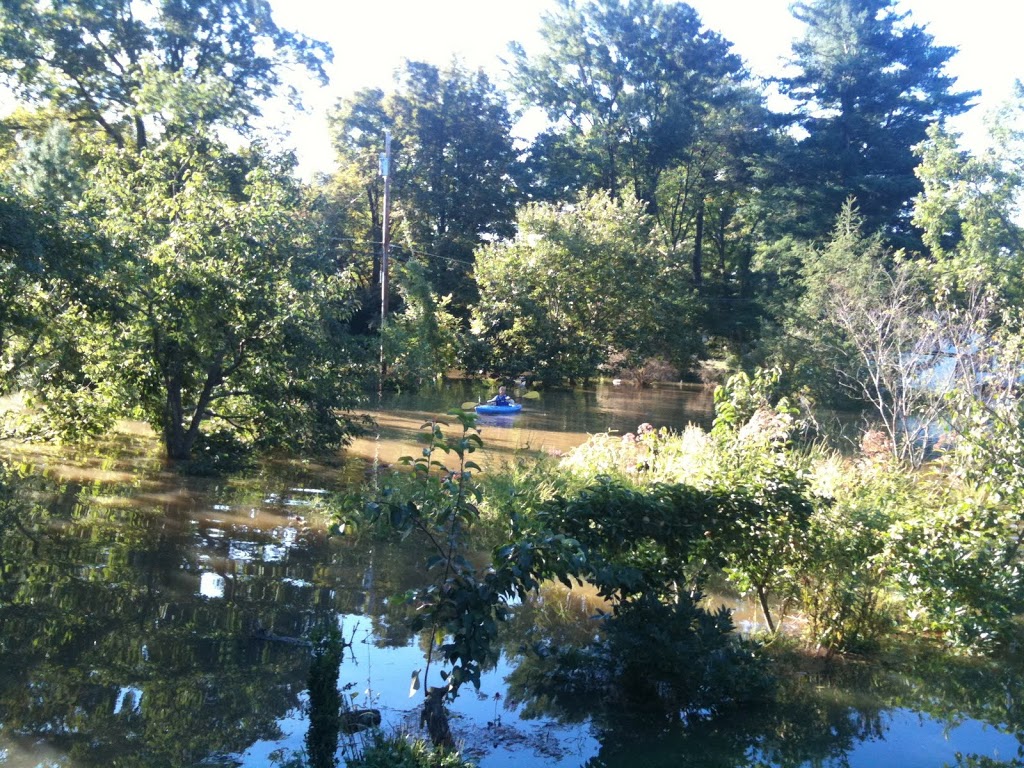TREES OF JOY & LAWN NOUVEAU
I didn’t need the house number to hone in on Bassem’s home in Bethlehem, Pennsylvania last Saturday. The Asian persimmon, pawpaw, and fig trees rising above the front hedge distinguished the landscape from those of the neighbors’ more conventional — and much less luscious — home grounds. Over the years, I have corresponded with Bassem, a fellow member of North American Fruit Explorers (www.nafex.org), and had planned to sometime stop by on one of my frequent trips to Philadelphia. Finally, I took that fruitful side step.
And what a fruitfully timely fruit step I hoped it to be: Fig season! Figs are a main interest of Bassem (http://www.treesofjoy.com/), who grew up in Lebanon. His quarter acre house lot, crammed with all sizes and varieties of fig trees, makes the collection of 35 varieties that I once grew in Maryland look like child’s play.
But figs were not all of it. Everywhere I looked was an interesting fruit plant. Hardy passionfruits (Passiflora incarnata), which I also grow, covered the ground among his foundation plantings, even sprouted up in the lawn. Did I write “foundation plantings?” Lest that conjure up an image of your standard junipers and yews, Bassem’s foundation plantings were more diverse and, of course, fruitful. There was the edible cactii (Opuntia spp.), a pomegranate with ripening fruit (the fruits on my potted pomegranates, which I mentioned early in summer, fell off), and, of course, many varieties of figs.
The backyard is home to a small greenhouse, in which Bassem overwinters some tropical fruits, and more fruit plants. A few large banana trees rose right next to the greenhouse — very decorative but not able, of course, to ripen fruit. They die to the ground each year and then sprout from overwintered roots each spring. An eight-foot-tall papaya plant, grown from seeds sown in spring, was expectantly flowering but likewise won’t have time to ripen fruits. Fruiting trees in the ground included quince (Cydonia oblonga), jujube (Ziziphus jujuba, yes, the original jujube candy was made from candied jujube fruits), and, in the back, more Asian persimmons and pawpaws.
It’s too cold here in the Wallkill River valley to plant outdoors much of what Bassem plants right in the ground even though our homes are separated by only about 80 miles of latitude. My extra few degree of cold are the result of my more rural setting, with less heat-trapping concrete, and my valley, into which cold air settles. Still, I couldn’t resist going home with 2 new fig varieties (Black Bethlehem and Pontlican) and a strawberry guava, both in pots that I’ll move indoors for winter. If the figs prove especially tasty, they might get planted in the ground in my cool temperature greenhouse.
———————————————————-
Goldenrod in the south field has turned the landscape a glorious yellow color. The plants have been blooming there for weeks and weeks but the intensity has recently ratcheted up.
The reason for the increased color isn’t the weather; it’s the plants. There are dozens of goldenrod species not easily distinguished from each other, even by botanists. My field is, no doubt, home to a few species and the one now blooming seems to be the one in greatest abundance.
I mow most of the south field once a year, in spring, a schedule that suits the goldenrods well. Other parts of the field that I used to mow more frequently than once a year (for a volleyball court) are mostly grasses, Queen-Anne’s-lace, and chicory, but I see some goldenrod now finally creeping in. I keep a path mowed through the field that each year follows a different trajectory. The ghost of last year’s path is high with vegetation, but not goldenrod — yet. There’s even a tropical-looking patch in the field where the large leaves of sumac seedlings shoot skyward above the surrounding goldenrods. That sumac is the legacy of a brush pile that I burned there over 10 years ago.
It’s all very interesting and pretty.
———————————————-
And, for a little more fall color: Persimmons. The orange fruits — persimmon orange fruits — are ripening on my trees and dropping to the ground. (Isn’t it odd that a color should be named “persimmon orange” when so few people know this relatively uncommon fruit? I helped remedy that situation by devoting a chapter in my book Uncommon Fruits for Every Garden to persimmons.)
The persimmon fruits, as usual, are delectable, with a taste and texture of dried apricots that have been softened in water, dipped in honey, then given a dash of spice. Something like Oriental persimmons but with richer flavor and texture.
The trees, as usual, are bearing an abundant crop. In over two decades of growing this fruit, the trees have failed me only 2 years, both from a very late frost that didn’t allow time for ripening. Few fruits are easier to grow: no notable pests; no pruning; just plant and pick.
Ripening is important with American persimmon because few gustatory experiences are as horrendous as biting into an unripe persimmon. The feeling is akin to having a vacuum cleaner in your mouth, and spitting out the fruit doesn’t help. Unfortunately, fruits from some wild trees of this native plant never fully lose that awful flavor, which is why I grow named varieties that are known to have excellent flavor. Over two dozen such varieties exist.
This far north, we’re restricted to growing ones that taste good and will ripen within our relatively short growing season. Which is fine, because my two favorite varieties, Mohler and Szukis, are both cold hardy, ripen within our growing season, and taste as good as I would hope from any persimmon. Any fruit, perhaps. Persimmon’s botanical name, Diospyros, translates to “food of the gods.









Leave a Reply
Want to join the discussion?Feel free to contribute!